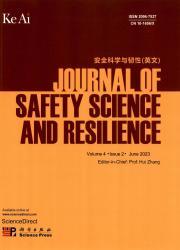将STPA扩展到有限状态机控制结构的建模
IF 3.4
Q1 PUBLIC, ENVIRONMENTAL & OCCUPATIONAL HEALTH
引用次数: 0
摘要
信息物理系统(cps)正变得越来越复杂,它将物理实体与各种计算和通信资源、多处理器、网络和设备集成在一起。一个例子是无人机系统(UAS)交通管理(UTM)系统,其中组件之间的相互作用可能导致UAS碰撞并对人员和财产造成伤害。系统理论过程分析(STPA)是一种基于系统理论的复杂系统早期安全分析技术。STPA中的“为控制结构建模”步骤涉及识别每个控制器组件、其过程模型及其控制动作。然而,传统的STPA流程模型仅使用变量和状态,这对于涉及通过多个状态流转换的实体的系统可能是不够的。本文通过将有限状态机(FSM)建模集成到模型控制结构步骤中,提出了一种新的扩展方法。基于fsm的方法通过在迭代过程中显式地建模其状态和转换来捕获需要控制的实体的详细行为。该扩展的STPA应用于UTM来控制无人机包裹的递送。结果表明,FSM扩展增强了对控制动作、反馈回路、过程模型变量和不安全控制动作的识别能力。研究表明,扩展的STPA为分析具有复杂状态转换的实体的cps提供了一种系统方法,有助于提高安全性分析的系统化和一致性。本文章由计算机程序翻译,如有差异,请以英文原文为准。

Extending the STPA to model the control structure with Finite State Machine
Cyber–physical systems (CPSs) are becoming increasingly complex, integrating physical entities with diverse computing and communication resources, multiple processors, networks, and devices. One example is the Unmanned Aircraft Systems (UAS) Traffic Management (UTM) system, where interactions among components can lead to UAS collisions and harm to people and property. System Theoretic Process Analysis (STPA) is a systems theory-based technique for conducting early-stage safety analyses of complex systems. The Model the Control Structure step in STPA involves identifying each controller component, its process models, and its control actions. However, conventional STPA process models use only variables and states, which may be insufficient for systems involving entities that transition through multiple state flows. This study introduces a novel extension by integrating Finite State Machine (FSM) modeling into the Model the Control Structure step. The FSM-based approach captures detailed behaviors of entities requiring control by explicitly modeling their states and transitions in an iterative process. This extended STPA was applied to the UTM to control the delivery of UAV packages. The results demonstrate that the FSM extension enhances identifying control actions, feedback loops, process model variables, and unsafe control actions. The study concludes that the extended STPA provides a systematic approach for analyzing CPSs with entities that undergo complex state transitions, contributing to improved systematization and consistency of safety analyses.
求助全文
通过发布文献求助,成功后即可免费获取论文全文。
去求助
来源期刊

安全科学与韧性(英文)
Management Science and Operations Research, Safety, Risk, Reliability and Quality, Safety Research
CiteScore
8.70
自引率
0.00%
发文量
0
审稿时长
72 days
 求助内容:
求助内容: 应助结果提醒方式:
应助结果提醒方式:


